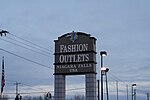102nd Street chemical landfill
Love CanalNiagara Falls, New YorkSuperfund sites in New York (state)Vague or ambiguous time from May 2019

The 102nd Street chemical landfill, is a former chemical landfill located on the Niagara River in Niagara Falls, New York. It is almost immediately adjacent to the infamous Love Canal chemical landfill, which are split from each other by the LaSalle Expressway and Frontier Avenue. Hooker Chemical Company, a subsidiary of Occidental Petroleum, and Olin Chemical, who were the original owners of the site, were ordered to clean up the site and pay $16,500,000 by the United States Environmental Protection Agency. It is a designated Superfund site, and is closed to the public.
Excerpt from the Wikipedia article 102nd Street chemical landfill (License: CC BY-SA 3.0, Authors, Images).102nd Street chemical landfill
100th Street, City of Niagara Falls
Geographical coordinates (GPS) Address External links Nearby Places Show on map
Geographical coordinates (GPS)
| Latitude | Longitude |
|---|---|
| N 43.07368 ° | E -78.94852 ° |
Address
102nd Street Chemical Landfill Site
100th Street
14304 City of Niagara Falls
New York, United States
Open on Google Maps







